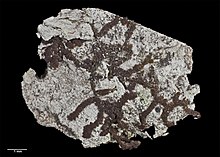| Frullania wairua | |
|---|---|

| |
| Scientific classification | |
| Kingdom: | Plantae |
| Division: | Marchantiophyta |
| Class: | Jungermanniopsida |
| Order: | Porellales |
| Family: | Frullaniaceae |
| Genus: | Frullania |
| Species: | F. wairua
|
| Binomial name | |
| Frullania wairua von Konrat & Braggins
| |
Frullania wairua, the spirit liverwort or radar bush liverwort, is a species of liverwort in the order Porellales. It is one of 24 species in the large genus Frullania that are native to New Zealand. The species was first described by Matt von Konrat and John Braggins in 2005 in the New Zealand Journal of Botany.[2]
Etymology[edit]
The specific epithet wairua is a Maori word that means "spirit". The name refers to the habitat of the species, which is near the tip of Cape Reinga. In Maori traditions, spirits travel to a pōhutukawa tree (Metrosideros excelsa) at the end of Cape Reinga after death, and then descend into the water to reunite with their ancestors.[3]
Description[edit]

The spirit liverwort is a small plant, with central shoots only 750 micrometres (μm) wide. It is olive-green in colour, and smaller shoots branch out in pairs from the sides of the main shoots.[4][3]
The first branches have an underleaf that is divided into three segments, while the leaf is divided in half into two segments. The stem leaves on the main shoot are a flat oval shape (when either wet or dry) and slightly overlap.[5] They measure 300 μm long and 225 μm, with flat edges and ends that can be rounded or pointy. Their base is either flat or somewhat round, and their topside surface is flat. Under each main leaf is a small lobule that is attached to the stem by only a few cells. They spread out diagonally at an angle of 30–50 degrees, tilting outwards from the stem. The lobules have a blunt end and measure 125 μm long and 80 μm wide.[4][3]
On all collected specimens of Frullania wairua, the only reproductive structures observed were female gynoecia. As such, the species is believe to be dioicous, with male and female structures occurring on separate plants. Each gynoecium is on the end of a leading stem and carries one flower-like structure, with a series of bracts and one or two branches surrounding it. The innermost bract has two lobes of uneven size, and every bract lobe has several rough serrations along its edge. Each gynoecium has three archegonia which carry the egg cells. About half of the perianth sticks out from the surrounding structures, and it is a stretched oval shape with a somewhat triangular cross-section.[4][3]
Ecology[edit]
Frullania wairua grows on canopy twigs of Bartlett's rata tree. It has been found on just four individual trees, and is entirely absent from related trees like rata, pohutukawa, mamangi, and maire tawake.[4] Because of its rarity, and because the tree it grows on is rapidly declining in population, Frullania wairua is at risk of becoming extinct. It has been classified as Nationally Critical in New Zealand.[4]
References[edit]
- ^ "Frullania wairua". nztcs.org.nz. Department of Conservation. 2020. Retrieved 30 January 2024.
- ^ "NZOR Name Details - Frullania wairua von Konrat & Braggins". New Zealand Organisms Register. Retrieved 2 March 2024.
- ^ a b c d von Konrat & Braggins 2005, p. 888.
- ^ a b c d e "Frullania wairua". New Zealand Plant Conservation Network. Retrieved 6 February 2024.
- ^ von Konrat & Braggins 2005, p. 886.
Bibliography[edit]
- von Konrat, Matt; Braggins, John (2005). "Frullania wairua, a new and seemingly rare liverwort species from Northland, New Zealand". New Zealand Journal of Botany. 43 (4): 885–893. Bibcode:2005NZJB...43..885V. doi:10.1080/0028825X.2005.9512998.
External links[edit]
- Frullania wairua discussed on RNZ Critter of the Week, 7 April 2017
